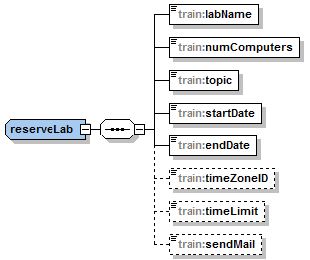ReserveLab
Reserves lab computers in a Hand-on Lab for a specific time.
Request
The following schema diagram shows the structure of the elements in thereserveLab request message.
Figure 6-38 • Schema diagram for reserveLab
The sample XML document requests to reserve 1 computer in the
lab named “Lab2” for 1 hour.
<?xml version="1.0" encoding="UTF-8"?>
<serv:message xmlns:xsi="http://www.w3.org/2001/XMLSchema-instance"
xmlns:serv="http://www.webex.com/schemas/2002/06/service">
<header>
<securityContext>
<webExID>steve</webExID>
<password>pass</password>
<partnerID>partnerid</partnerID>
<siteName>johnsmith@xyz.com</siteName>
</securityContext>
</header>
<body>
<bodyContent
xsi:type="java:com.webex.service.binding.training.ReserveLab">
<labName>Lab2</labName>
<numComputers>1</numComputers>
<topic>reserve test01</topic>
<timeLimit>60</timeLimit>
<startDate>04/20/2011 10:00:00</startDate>
<endDate>04/20/2011 11:00:00</endDate>
<timeZoneID>4</timeZoneID>
<sendMail>false</sendMail>
</bodyContent>
</body>
</serv:message>
For descriptions of the global elements in the security context of the
header, please see Global Request Elements in Security Context.
For descriptions of the non-global elements, please refer to “Elements
in WebEx XML Schema Definitions for the Training Session Service”.
Response
The following schema diagram shows the structure of the elements in thereserveLabResponse message.
Figure 6-39 • Schema diagram for reserveLabResponse
The sample XML document shows an example of a possible response to the
preceding request document.
<?xml version="1.0" encoding="UTF-8"?>
<serv:message xmlns:serv="http://www.webex.com/schemas/2002/06/service"
xmlns:com="http://www.webex.com/schemas/2002/06/common"
xmlns:sess="http://www.webex.com/schemas/2002/06/service/session"
xmlns:train="http://www.webex.com/schemas/2002/06/service/trainingsession"
xmlns:qti="http://www.webex.com/schemas/2002/06/service/trainingsessionqti"
xmlns:qtiasi=
"http://www.webex.com/schemas/2002/06/service/trainingsessionqtiasi">
<serv:header>
<serv:response>
<serv:result>SUCCESS</serv:result>
<serv:gsbStatus>PRIMARY</serv:gsbStatus>
</serv:response>
</serv:header>
<serv:body>
<serv:bodyContent xsi:type="train:ReserveLabResponse"
xmlns:xsi="http://www.w3.org/2001/XMLSchema-instance" />
<train:holSessionID>65192</train:holSessionID>
</serv:bodyContent>
</serv:body>
</serv:message>
The result and exceptionID global elements allow you to confirm that
an instantiation request was successful. They are described in "Global Response
Elements Showing Results and Errors”.

